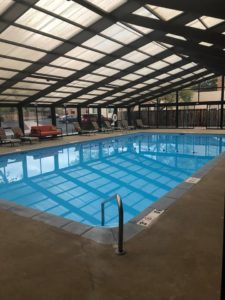In October 2016, the Town of Taos received $500,000 in Community Development Block Grant (CDBG) funds to work with a local developer to renovate the Hotel Don Fernando, whose former owners had lost the business through foreclosure. The mid-town hotel had become a hub of illegal activity and vandalism: too expensive for the developer to singlehandedly bring up to code but too visible a blight on the town’s main thoroughfare for town officials to ignore and a waste of potential gross receipts revenue for the tourism-dependent town.
The Town of Taos became fiscal agent for the U.S. Housing and Urban Development (HUD) funds, and the developer matched that money, reopening the 30-year-old, 126-room hotel two years later under the Hilton Tapestry banner. The federal funds helped the new owner address more than 100 code violations and purchase hotel furnishings.
Of the hotel’s nearly three dozen employees, 91 percent qualify as low to middle income (LMI). That number exceeds the grant requirement that at least 51 percent of jobs created by CDBG funds go to people whose household income is 80 percent or less than the median income for their county or area.
Creating Jobs Together
While most CDBG funds underwrite water and other infrastructure projects that benefit local communities, a portion is reserved for planning, housing and economic development projects that local governments conduct in partnership with private companies to create permanent jobs for LMI residents.
The state’s largest cities — Albuquerque, Rio Rancho, Las Cruces, Santa Fe and Farmington — receive annual CDBG grants on a formula basis as entitlement cities and can apply directly to HUD. The state’s Department of Finance and Administration (DFA) receives an allotment to award to communities that meet HUD eligibility requirements, and the agency helps these applicants with the process.
Public works projects that support private ventures — for example, extending a road to a planned industrial building that will employ low to middle income workers — qualify as economic development undertakings. Acquiring, constructing, rehabilitating or installing commercial or industrial buildings, structures and other real property equipment and improvements also meet requirements.
To qualify for an economic development grant, the applicant municipality must demonstrate that jobs will meet or exceed the LMI target and provide opportunities for LMI workers, many of whom lack a college education or substantial work experience.
Workshop Aims to Help
Economic development grants are capped at $500,000, and private partners must match government funds dollar for dollar. Every $35,000 in grant funds must create at least one job, and 51 percent of all jobs must go to LMI individuals.
New Mexico’s annual allocation of total CDBG program grants has averaged $10 million for the past three years. It’s up to the state’s Community Development Council to decide which portion is earmarked for economic development as opposed to infrastructure development.
Applying for any type of CDBG grant is labor intensive, because it requires extensive research to compile specific, verifiable data about the applicant’s project. For that reason, the DFA offers an annual workshop, with this year’s set for March 5. Contact Stephen Weinkauf at the DFA’s Local Government Division at Stephen.weinkauf@state.nm.us for more information.
Finance New Mexico article 592

